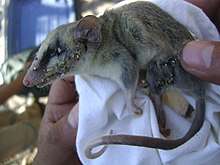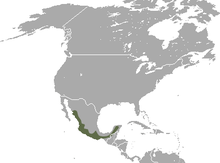Grayish mouse opossum
The grayish mouse opossum (Tlacuatzin canescens) is a species of opossum endemic to Mexico. It is the sole species in the genus Tlacuatzin.
| Grayish mouse opossum | |
|---|---|
 | |
| In Oaxaca, Mexico | |
| Scientific classification | |
| Kingdom: | Animalia |
| Phylum: | Chordata |
| Class: | Mammalia |
| Infraclass: | Marsupialia |
| Order: | Didelphimorphia |
| Family: | Didelphidae |
| Subfamily: | Didelphinae |
| Tribe: | Marmosini |
| Genus: | Tlacuatzin Voss and Jansa, 2003 |
| Species: | T. canescens |
| Binomial name | |
| Tlacuatzin canescens J. A. Allen, 1893 | |
 | |
| Grayish mouse opossum range | |
| Synonyms | |
|
Marmosa canescens | |
Description
The grayish mouse opossum is an unusually small opossum, measuring 20 to 35 cm (7.9 to 13.8 in) in total length, including an 11- to 16-cm (4.3- to 6.3-in) tail. Adults weigh from 38 to 60 g (1.3 to 2.1 oz). The body is covered in short, soft fur, with a slightly woolly texture. As the common name suggests, the fur is pale to brownish grey in colour, fading to white or near-white on the under parts and legs. In addition, clearly visible rings of black hair occur around the eyes, and, on females, patches of orange fur in the groin region, sometimes extending to the thighs and up the midline almost to the throat.[2]
The whiskers are relatively short, and the ears are rounded, hairless, and dark in colour. The tail is long and prehensile, and hairless for almost all of its length, apart from the base. Females have nine teats, but, unlike many other marsupials, do not have a pouch.[2]
Distribution and habitat
It is endemic to Mexico from southern Sonora to Oaxaca, with populations also on the Islas Marías and in the central Yucatán Peninsula.[1] It occupies seasonally arid habitats, especially mixed deciduous forests, but also scrub, grassland, and agricultural land. It has been reported up to elevations of 2,100 m (6,900 ft), although it is more commonly found below 1,000 m (3,300 ft).[2] Two subspecies are currently recognised:[3]
- Tlacuatzin canescens canescens - Majority of range
- Tlacuatzin canescens gaumeri - Yucatán Peninsula
Biology and behaviour
The grayish mouse opossum is solitary and semiarboreal, being more terrestrial in its habits than other mouse opossums.[1] They have been reported to travel no more than 72 m (236 ft) between feeding sites, suggesting a small home range.[2] Population densities have been reported to range from 0.4 to 4.5 per hectare (0.16 to 1.82/acre).[4] The species has an omnivorous diet, but feeds mainly on insects such as bugs, cockroaches, moths, and beetles. It occasionally feeds on small lizards and bird eggs, and also feeds on fruit such as figs, coconuts, and oranges. Predators include barn owls and pumas.[2][5]
A nocturnal animal, the grayish mouse opossum spends the day in nests, generally in forks or hollows of trees, bushes or cacti, or in rock crevices. The nests are globular, constructed of leaves and stems, and lined with grass or plant fibres, such as the "cotton" obtained from kapok trees.[2] It may also use the abandoned hanging nests of orioles or wrens.[1]
Breeding occurs in late summer and early autumn.[1] The animals mate while hanging upside down from their tails, with the male tightly holding onto the female's neck with its jaws. The litter size ranges from 8 to 14.[4] The young attach themselves to teats shortly after birth, and are sheltered by a pouch-like layer of hair, in the absence of a true pouch. The young leave the nest once they reach about 20 g (0.7 oz) in weight.[2]
Parasites
Not many parasites have been recorded from the grayish mouse opossum. The pinworm Tlacuatzoxyuris simpsoni (Nematoda, Oxyuridae), a parasite of the cecum, has been described in 2019.[6]
References
- Cuarón, A.D.; Emmons, L.; Helgen, K.; Reid, F. & Vazquez, E. (2008). "Tlacuatzin canescens". IUCN Red List of Threatened Species. 2008. Retrieved 22 October 2011.CS1 maint: ref=harv (link)
- Zarza, H.; et al. (2003). "Marmosa canescens". Mammalian Species. 725: Number 725: pp. 1–4. doi:10.1644/1545-1410(2003)725<0001:MC>2.0.CO;2.
- Gardner, A.L. (2005). "Order Didelphimorphia". In Wilson, D.E.; Reeder, D.M (eds.). Mammal Species of the World: A Taxonomic and Geographic Reference (3rd ed.). Johns Hopkins University Press. p. 18. ISBN 978-0-8018-8221-0. OCLC 62265494.
- Ceballos, G. (1990). "Comparative natural history of small mammals from tropical forest in western Mexico". Journal of Mammalogy. 71 (2): 263–266. doi:10.2307/1382182. JSTOR 1382182.
- Núñez, R.; et al. (2000). "Food habits of jaguars and pumas in Jalisco, Mexico". Journal of Zoology. 252 (3): 373–379. doi:10.1111/j.1469-7998.2000.tb00632.x.
- Jiménez, F. Agustín; Caspeta-Mandujano, Juan Manuel; Albino-Miranda, Sergio (2019). "A new genus and species of pinworm (Nematoda, Oxyuridae) from the gray mouse opossum, Tlacuatzin canescens". Parasite. 26: 50. doi:10.1051/parasite/2019054. ISSN 1776-1042. PMC 6702828. PMID 31432779.

